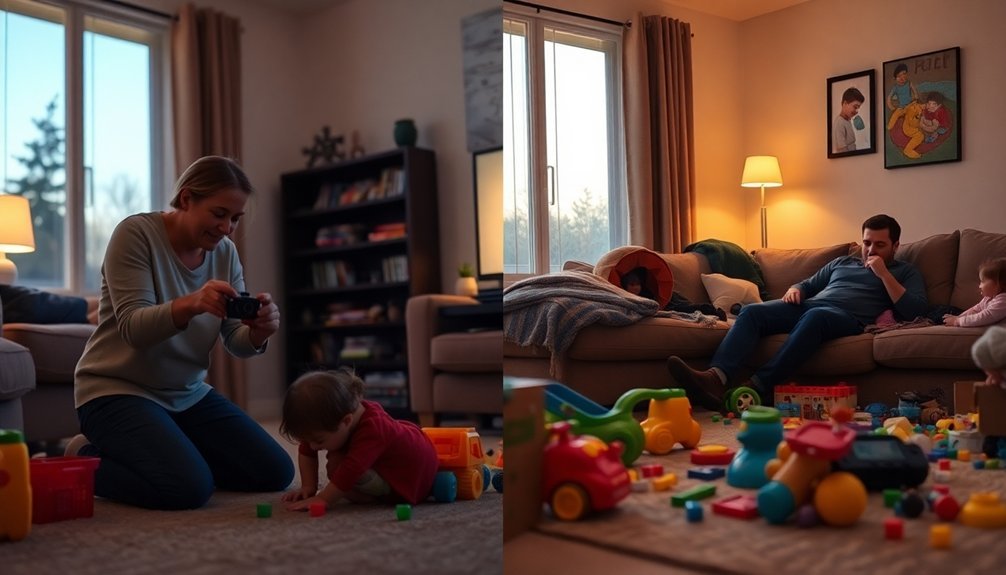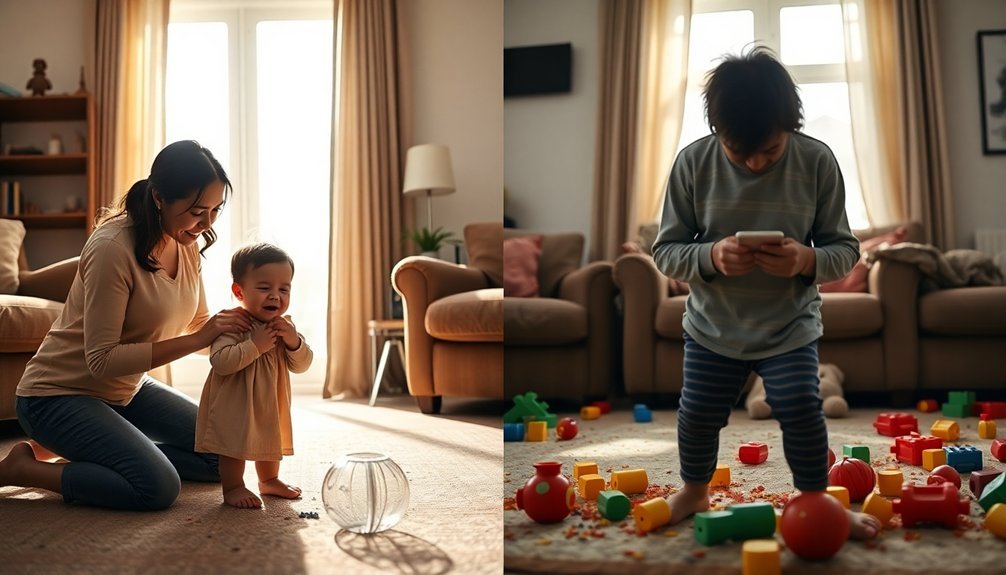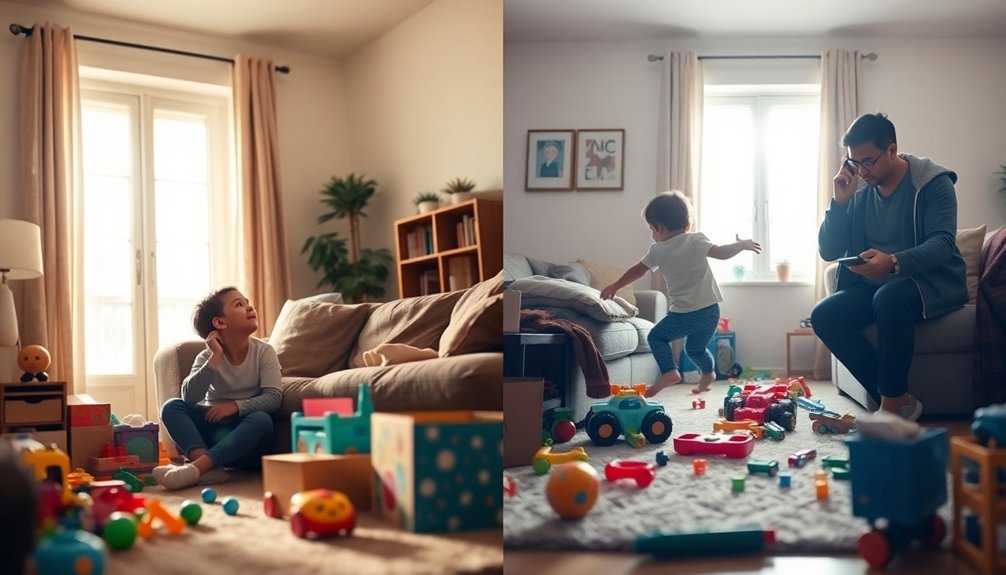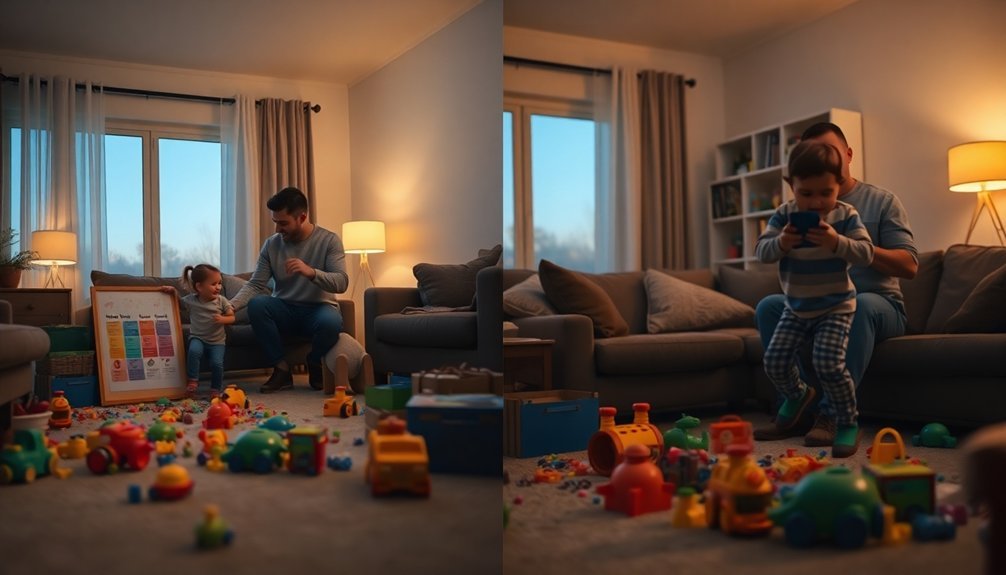Recent studies show that 63% of parents struggle to distinguish between gentle parenting and permissive parenting approaches, often confusing the two methods when attempting to implement them at home. You're not alone if you've wondered about the fine line between setting loving boundaries and giving in to your child's every whim. While both styles emphasize nurturing relationships with children, they differ fundamentally in their approach to discipline, structure, and long-term developmental outcomes. Understanding these significant differences won't just improve your parenting toolkit—it'll transform how you navigate daily challenges and shape your child's future behavior.
Key Takeaways
- Gentle parenting enforces consistent boundaries while maintaining empathy, whereas permissive parenting avoids setting limits to prevent conflict.
- Gentle parents teach accountability through natural consequences, while permissive parents rarely implement disciplinary measures.
- Emotional regulation is actively taught in gentle parenting, but often neglected in permissive parenting, affecting children's emotional development.
- Gentle parenting balances nurturing with clear expectations, while permissive parenting prioritizes freedom without providing necessary guidance.
- Children raised with gentle parenting develop stronger self-discipline and emotional intelligence compared to those raised permissively.
Core Principles of Each Approach
Gentle parenting's core principles rest on four main pillars: empathy, respect, understanding, and boundaries. When you practice this approach, you'll focus on responding to your child's needs while helping them develop emotional intelligence and self-regulation skills.
You'll need to recognize your child's feelings as valid while guiding them toward appropriate behaviors through connection rather than punishment.
Permissive parenting, in contrast, operates on fundamentally different core values. While this style emphasizes nurturing and emotional warmth, it lacks consistent boundaries and consequences.
You'll find that permissive parents often avoid confrontation and struggle to enforce rules, potentially hindering their parenting goals of raising responsible, well-adjusted children.
The key distinction lies in structure and accountability. In gentle parenting, you'll maintain firm boundaries while showing compassion, teaching your child about natural consequences and emotional regulation.
You're actively involved in guiding behavior, whereas permissive parenting takes a more hands-off approach. While both styles aim to create loving relationships, gentle parenting provides the framework children need to develop self-discipline and emotional maturity, making it a more balanced and effective approach.
Setting and Enforcing Boundaries

While gentle parenting establishes clear, age-appropriate boundaries that you'll enforce consistently, permissive parenting typically lacks defined rules or follows through irregularly with limits.
You'll find that gentle parents set reasonable expectations and follow through with related consequences, helping children understand the natural outcomes of their choices.
In contrast, permissive parents often avoid enforcing boundaries to prevent conflict, which can leave children feeling insecure about behavioral expectations and limits.
Clear Rules vs. None
Setting clear boundaries marks a fundamental difference between gentle and permissive parenting approaches. In gentle parenting, you'll establish clear expectations while maintaining flexibility to accommodate your child's developmental needs.
You're creating a framework that helps your child understand their limits while feeling secure in their environment. This approach balances structure with compassion, allowing your child to learn responsibility within reasonable guidelines.
Permissive parenting, however, often lacks defined rules or consistent expectations. You might find yourself avoiding setting boundaries to prevent conflict or maintain your child's happiness.
While this may seem kind in the moment, it can leave your child feeling uncertain about acceptable behavior and struggling to develop self-discipline.
When you implement clear rules through gentle parenting, you're providing flexible guidelines that can evolve as your child grows.
You'll explain the reasoning behind rules, involve your child in decision-making when appropriate, and maintain consistency in enforcement.
This creates a predictable environment where your child can thrive, develop emotional intelligence, and understand the natural consequences of their actions while feeling supported and respected.
Consistent vs. Irregular Limits
A parent's steadfast commitment to boundaries forms the cornerstone of gentle parenting's effectiveness. When you maintain consistent communication about limits and expectations, your child develops a secure understanding of their environment.
Unlike permissive parenting, where boundaries shift unpredictably, gentle parenting establishes reliable guidelines that help children thrive.
In gentle parenting, you'll maintain the same core boundaries day after day, though you might adjust them as your child grows. This consistency helps your child predict outcomes and develop self-regulation skills. For example, if screen time ends at 7 PM today, it should end at 7 PM tomorrow.
Irregular expectations, common in permissive parenting, leave children confused about what's acceptable, potentially leading to anxiety and behavioral challenges.
Your consistent limits don't mean inflexibility – they mean reliability. When children understand that certain boundaries won't waiver (like safety rules or respect for others), they're more likely to internalize these values.
While permissive parenting's irregular enforcement might seem easier in the moment, it ultimately creates uncertainty that can hinder your child's emotional development and sense of security.
Following Through With Consequences
Consistent boundaries work hand-in-hand with meaningful consequences in gentle parenting. When you follow through with stated consequences, you're teaching your child accountability importance while building trust in your parental guidance. Unlike permissive parenting, gentle parenting emphasizes consequences clarity – ensuring your child understands the direct connection between their choices and outcomes.
| Gentle Parenting | Permissive Parenting |
|---|---|
| States clear consequences | Avoids consequences |
| Follows through consistently | Makes empty threats |
| Maintains loving connection | Fears child's disappointment |
| Uses natural consequences | Shields from outcomes |
| Teaches responsibility | Enables dependency |
You'll find that following through isn't about punishment but rather about helping your child learn from their experiences. When you maintain consistent consequences while staying emotionally connected, you're supporting your child's development of self-discipline. Research shows that children thrive when they understand the predictable relationship between their actions and outcomes. By remaining calm and firm while implementing consequences, you're modeling emotional regulation and teaching valuable life skills. This approach helps your child develop internal motivation rather than relying on external control.
Emotional Support and Communication

Through consistent emotional validation and open dialogue, gentle parenting builds strong parent-child relationships that foster trust and understanding. When you practice gentle parenting, you'll create a deep emotional connection by acknowledging your child's feelings, even during challenging moments.
Active listening becomes your tool for understanding their perspective, helping them feel heard and valued. Unlike permissive parenting, which often avoids difficult conversations, gentle parenting embraces honest communication while maintaining appropriate boundaries.
You'll learn to validate emotions without necessarily validating undesirable behaviors. For example, you might say, "I understand you're angry about bedtime, and it's okay to feel that way" while still maintaining the bedtime routine.
Your responses should consistently demonstrate empathy while guiding your child toward emotional intelligence. This means teaching them to identify, express, and manage their feelings effectively.
When you model calm communication during conflicts, you're showing your child how to handle difficult emotions constructively. Remember, the goal isn't to suppress emotions but to help your child process them in healthy ways while maintaining the secure attachment that's central to gentle parenting.
Discipline Methods and Consequences

Building on the foundation of emotional support, discipline in gentle parenting takes a markedly different approach from both traditional punitive methods and permissive parenting's lack of boundaries.
In gentle parenting, you'll focus on natural consequences while maintaining firm, age-appropriate limits. Unlike permissive parenting, which often avoids confrontation and lets misbehavior slide, gentle parenting actively addresses challenging behaviors through respectful guidance.
When your child misbehaves, you'll help them understand the impact of their actions rather than imposing arbitrary punishments. For example, if they refuse to wear a coat, they'll experience the natural consequence of feeling cold. This approach differs from behavior modification through rewards and punishments, as it emphasizes learning from experience rather than external control.
You'll set clear expectations while remaining responsive to your child's developmental stage. If your toddler hits, you'll firmly state "We don't hit" while offering alternative ways to express frustration.
This balanced approach maintains boundaries without shame or punishment, teaching children responsibility while preserving their dignity and your relationship with them.
Child Development Impact

When you practice gentle parenting, you'll help your child develop stronger emotional intelligence through validation and understanding of their feelings, while permissive parenting often leaves children struggling to process emotions effectively.
You'll find that gentle parenting's clear, consistent boundaries support your child's development of self-regulation skills, whereas permissive parenting's lack of limits can lead to poor impulse control.
Research shows that children raised with gentle parenting techniques develop more robust emotional coping mechanisms and healthier relationship patterns than those raised in permissive households.
Emotional Intelligence Development
Parents who practice gentle parenting up and down the emotional spectrum tend to raise children with higher emotional intelligence compared to those using permissive approaches. When you set clear boundaries while acknowledging your child's feelings, you're helping them develop essential emotional awareness.
Through gentle parenting, you'll guide your children to understand and process their emotions rather than suppress them, leading to better self-regulation skills in the long run.
Permissive parenting, in contrast, often leaves children struggling to develop strong empathy skills because they haven't learned to balance their emotional needs with those of others.
You'll notice that children raised with gentle parenting techniques show greater ability to recognize and respond to others' feelings appropriately. They're more likely to develop healthy relationships and navigate social situations successfully.
Boundaries and Self-Regulation
Clear boundaries serve as the foundation for healthy self-regulation in child development, yet they're implemented quite differently between gentle and permissive parenting styles.
While gentle parents establish and maintain consistent boundaries with empathy, permissive parents often struggle to uphold limits, leading to challenges in their children's self-regulation development.
Understanding the boundaries importance in each style reveals stark contrasts in outcomes.
Gentle parenting emphasizes teaching self-regulation techniques through guided practice and natural consequences, while permissive parenting may inadvertently hinder a child's ability to develop these essential skills.
Consider these emotional impacts of boundary-setting approaches:
- Your child feels secure and understood when you consistently enforce boundaries with compassion, fostering trust in your guidance.
- Your child develops stronger emotional resilience when you help them navigate disappointment rather than avoiding it.
- Your child learns valuable coping skills when you model healthy self-regulation during challenging moments.
- Your child builds confidence in their decision-making abilities when you provide clear, age-appropriate limits while respecting their autonomy.
Research shows that children thrive when parents balance nurturing support with appropriate boundaries, creating a framework for lasting emotional wellness.
Parent-Child Power Dynamics

At the core of both gentle and permissive parenting lies the fundamental question of power distribution between parent and child. While both approaches aim to reduce traditional authoritarian dynamics, they differ greatly in how they handle authority balance.
In gentle parenting, you'll maintain your parental authority while actively working to create a collaborative relationship with your child. You're still the guide, but you'll focus on teaching rather than commanding, helping your child understand the 'why' behind limits and expectations.
This approach creates a healthy power dynamic where your child feels respected but also secure in your leadership.
Permissive parenting, however, often surrenders too much authority to the child. You might find yourself avoiding confrontation or setting limits out of fear of upsetting your child, which can create unstable power dynamics.
Without clear leadership, children may feel anxious or overwhelmed by having too much control.
The key difference lies in how authority is exercised: gentle parenting maintains a balanced power structure through respectful guidance, while permissive parenting creates an authority vacuum that can leave children feeling insecure and unsupported.
Common Misconceptions and Myths

Popular myths surrounding gentle parenting often stem from a fundamental misunderstanding of its core principles. When you hear criticisms of this approach, you'll often encounter misunderstood intentions and parenting stereotypes that don't reflect the true nature of gentle parenting practices.
You'll find these common misconceptions particularly frustrating if you've embraced gentle parenting:
- "Gentle parents don't set boundaries" – In reality, you're setting clear, age-appropriate limits while maintaining connection with your child.
- "Children won't learn consequences" – Your child actually develops deeper understanding through natural and logical consequences, rather than punitive measures.
- "It's just permissive parenting with a new name" – You're actively engaged in guiding your child's behavior, not simply allowing everything.
- "Children won't develop resilience" – Your child builds stronger emotional regulation skills through supported experiences.
These myths often prevent parents from exploring gentle parenting techniques, fearing they'll raise undisciplined children.
However, research shows that children raised with respectful guidance and emotional support develop stronger self-discipline and social awareness than those raised with traditional authoritarian methods.
Building Structure and Consistency

Moving beyond misconceptions, structure and consistency form the bedrock of successful gentle parenting approaches. When you establish clear boundaries and predictable routines, you're actually strengthening your child's sense of security while teaching valuable life skills. The structure importance in gentle parenting lies in creating a framework that allows children to understand expectations while feeling supported in their growth.
You'll find that consistency benefits emerge through daily routines, clear communication, and predictable responses to behavior. Unlike permissive parenting, gentle parenting doesn't shy away from setting limits – it simply approaches them with empathy and respect. You can maintain firm boundaries while explaining the reasoning behind rules and acknowledging your child's feelings.
To build effective structure, establish regular meal times, bedtime routines, and clear family guidelines. When your child knows what to expect, they're better equipped to regulate their emotions and behavior.
Remember that consistency doesn't mean rigidity; it means providing reliable, loving guidance while remaining flexible enough to meet your child's developmental needs. This balanced approach helps children develop self-discipline and emotional intelligence within a secure framework.
Frequently Asked Questions
At What Age Should Parents Transition From Traditional to Gentle Parenting?
There's no specific changeover age for changing parenting styles, as you can start gentle parenting at any time.
You'll find it's most effective to begin as early as possible, even during infancy, but it's never too late to shift your approach.
How Do Grandparents and Caregivers Adapt to Gentle Parenting Methods?
Picture a bridge connecting traditional wisdom with modern approaches – that's where grandparent involvement meets gentle parenting.
You'll want to start by sharing gentle parenting resources with your child's caregivers and explaining your family's specific boundaries and communication style.
It's helpful to demonstrate these techniques in action, showing how you respond to challenging moments.
Can Gentle Parenting Work Effectively in Large Families With Multiple Children?
Yes, you can effectively implement gentle parenting in large families by focusing on consistent family routines and understanding sibling dynamics.
You'll need to dedicate time for individual connections with each child while fostering cooperation between siblings.
Set clear expectations, create predictable schedules, and encourage older children to model emotional regulation.
Does Gentle Parenting Require Both Parents to Follow the Same Approach?
Like a well-choreographed TikTok dance, co-parenting dynamics work best when you're in sync.
While it's ideal for both parents to follow gentle parenting principles, you can still make a positive impact even if your partner uses different methods.
However, you'll see the most success with a unified approach, as children thrive on consistency.
When both parents commit to gentle parenting, you're creating a more stable, predictable environment that supports your child's emotional development.
How Does Gentle Parenting Handle Conflicts Between Siblings?
When managing sibling rivalry, you'll want to focus on teaching conflict resolution skills rather than simply breaking up fights.
Start by acknowledging each child's feelings and help them express their needs clearly. You can guide them through problem-solving steps, encouraging them to find solutions together.
It's important that you remain neutral and avoid taking sides, instead helping your children develop empathy and understanding for each other's perspectives.
Conclusion
Ever wondered why some children thrive with boundaries while others struggle without them? That's where understanding the distinction between gentle and permissive parenting becomes essential. You'll find that gentle parenting's balanced approach of empathy with clear limits creates more resilient, emotionally intelligent children than permissive parenting's lack of structure. By choosing gentle parenting, you're investing in your child's future emotional wellbeing and self-regulation skills.




0 responses to “Gentle Parenting vs. Permissive Parenting: What’s the Real Difference?”
Isnt Gentle Parenting just a fancy term for Permissive Parenting with better PR? Arent we just justifying lack of discipline in a new way?
Isnt true, permissive parenting often mistaken for gentle parenting due to the lack of clear-cut rules? Its not the same, folks!
Interesting read! But arent clear rules part of setting boundaries? Seems like theyre overlapping concepts, no? What are your thoughts, guys?
Interesting comparison, but isnt it plausible that the best approach might be a blend of both Gentle and Permissive parenting?